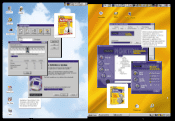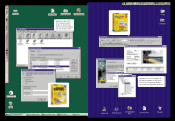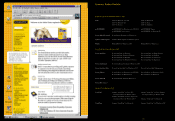Symantec 1998 Annual Report Download - page 19
Download and view the complete annual report
Please find page 19 of the 1998 Symantec annual report below. You can navigate through the pages in the report by either clicking on the pages listed below, or by using the keyword search tool below to find specific information within the annual report.
SYMANTEC CORPORATION
SYMANTEC CORPORATION 25
$23 million of the valuation allowance for
deferred tax assets is attributable to unbene-
fitted stock option deductions, the benefit
of which will be credited to equity when
realized. The remaining $2 million of the
valuation allowance represents net operat-
ing loss and tax credit carryforwards of
various acquired companies that are li-
mited by separate return limitations and
under the “change of ownership” rules of
Internal Revenue Code Section 382.
Symantec projects the effective tax
rate to be 32% in fiscal 1999. This rate is
lower than the expected U.S. federal and
state combined statutory rate of 40% due
primarily to a lower tax rate from the
Company’s Irish operations. However,
this projection is subject to change due to
fluctuations in and the geographic alloca-
tion of earnings. (See further discussion in
Item 7: Management’s Discussion and
Analysis of Financial Condition and Results
of Operations - Fluctuations in Quarterly
Operating Results; Foreign Operations.)
LIQUIDITY AND CAPITAL
RESOURCES
Cash, short-term investments and long-
term investments increased $100 million to
$260 million at fiscal 1998 year-end from
$160 million at fiscal 1997 year-end. This
increase was largely due to cash provided
from operating activities, net proceeds
from the exercise of stock options and
net proceeds from the sales of common
stock under the Company’s Employee
Stock Purchase Plan.
In addition to cash, short-term invest-
ments and long-term investments of
$260 million, the Company has $59 million
of restricted investments related to collat-
eral requirements under lease agreements
entered into by Symantec during fiscal
1997. Symantec is obligated under certain
lease agreements for two existing office
buildings, one parcel of land and one
office building under construction in
Cupertino, California to maintain a
restricted cash balance invested in U.S.
treasury securities with maturities not to
exceed three years. In accordance with the
lease terms, these funds are not available
to meet operating cash requirements. (See
further discussion in Note 8 of Notes to
Consolidated Financial Statements in
Part IV, Item 14 of this Form 10-K.)
Net cash provided by operating
activities was $131 million and was com-
prised of the Company’s net income of
$85 million, non-cash related expenses of
$21 million and a net decrease in assets
and liabilities of $25 million.
Net trade accounts receivable increased
$20 million to $65 million at the end of
fiscal 1998 from $45 million at the end of
fiscal 1997, primarily due to increased
operating activities during fiscal 1998. With
the growth of international sales to 32%
of net revenues in fiscal 1998 from 29%
of net revenues in fiscal 1997, Symantec
is carrying an increased accounts receiv-
able balance with longer average standard
payment terms, as such longer payment
terms are standard business practice in cer-
tain international markets. At March 31,
1998, international days sale outstanding
was 48 days, as compared to 32 days for
North America.
During fiscal 1998, the Board of
Directors of Symantec authorized the
repurchase of up to 1,500,000 shares of
Symantec common stock. At the end of
fiscal 1998, a total of 1,000,000 shares were
repurchased at prices ranging from $16.57
to $26.81 per share. The authorized repur-
chase period has expired for the remaining
500,000 shares. The repurchased shares have
been reissued under the Company’s em-
ployee stock purchase and option programs.
The Company recently renewed its
$10 million line of credit to expire in
May 2000. The Company was in com-
pliance with the debt covenants for this
line of credit as of April 3, 1998. At the
end of fiscal 1998, there were no borrow-
ings outstanding and less than $1 million
of standby letters of credit outstanding
under this line. Future acquisitions by the
Company may cause the Company to be
in violation of the line of credit covenants.
However, the Company believes that if
the line of credit were canceled or amounts
were not available under the line, there
would not be a material adverse impact
on the financial results, liquidity or capi-
tal resources of the Company.
If Symantec were to sustain significant
losses, the Company could be required to
reduce operating expenses, which could
result in product delays; reassess acquisi-
tion opportunities, which could negatively
impact the Company’s growth objectives;
and/or pursue further financing options.
The Company believes existing cash and
short-term investments and cash generated
from operating results will be sufficient
to fund operations for the next year.
BUSINESS RISKS
The preceding discussion contains forward-
looking statements that are subject to risks
and uncertainties. There are several impor-
tant factors that could cause actual results
to differ materially from those anticipated
by the forward-looking statements con-
tained in the following discussion. Readers
should pay particular attention to the
risk factors set forth within this section.
Nothing in this report shall impose upon
Symantec or any person a duty to update
any forward-looking statement.
Fluctuations in Quarterly Operating
Results and Stock Price. Due to the fac-
tors noted below, the Company’s earnings
and stock price have been and may con-
tinue to be subject to significant volatility,
particularly on a quarterly basis. Symantec
has previously experienced shortfalls in
revenue and earnings from levels expected
by securities analysts and investors, which
has had an immediate and significant
24
actively marketed by Symantec were offset
by increased spending for new products
released during fiscal 1997.
General and Administrative
Expenses
In fiscal 1998, general and administrative
expenses increased by 12% to $38 million
from $34 million in fiscal 1997 and from
$33 million in fiscal 1996. General and
administrative expenses were 7% of net
revenues during fiscal 1998, 1997 and 1996.
General and administrative expenses
increased in fiscal 1998 as compared to
fiscal 1997 at a rate proportionate to net
revenue growth as the result of increased
personnel expenses associated with the
growth of the Company.
The fiscal 1997 increase in general
and administrative expenses, as compared
to fiscal 1996, is primarily the result of
management consulting expenditures,
offset by benefits from the elimination of
duplicative general and administrative
expenses as a result of the acquisition of
Delrina by Symantec in fiscal 1996.
Acquisition, Restructuring and
Other Expenses
No acquisition, restructuring and other
expenses were incurred in fiscal 1998.
Acquisition Expenses. In connection with
the acquisitions completed in fiscal 1997
and 1996 (see Summary of Significant
Accounting Policies and Note 3 of Notes
to Consolidated Financial Statements in
Part IV, Item 14 of this Form 10-K),
Symantec incurred significant acquisition-
related expenses.
Symantec recorded total acquisition
charges of approximately $1 million in
fiscal 1997 in connection with the acqui-
sition of Fast Track.
In connection with the acquisition of
Delrina in fiscal 1996, Symantec recorded
total acquisition charges of $22 million.
These acquisition expenses primarily
related to legal, accounting and financial
advisory services, elimination of duplica-
tive and excess facilities and equipment,
personnel severance and outplacement
services, and operational activities con-
solidation and discontinuance. Offsetting
these costs was a reduction in accrued
acquisition, restructuring and other
expenses of approximately $2 million, as
actual costs incurred related to certain
prior acquisitions were less than costs
previously accrued by the Company.
Restructuring Expenses. In fiscal 1997,
the Company recorded a charge of
approximately $3 million for costs related
to the restructuring of certain domestic
and international sales and research and
development operations, certain legal
settlements and other expenses. In fiscal
1996, the Company incurred approxi-
mately $2 million for equipment and
personnel relocation costs related to the
consolidation of certain research and
development activities. The restructuring
plans have been completed.
Other Expenses. In fiscal 1997, Symantec
recorded an approximately $2 million
charge in connection with the write-off
of an equity investment and an approxi-
mately $3 million charge for the write-
off of certain in-process research and
development acquired by the Company.
In fiscal 1996, Symantec incurred a
$3 million loss on the sale of the assets of
Time Line Solutions Corporation, a
wholly-owned subsidiary. Additionally,
in fiscal 1996, the Company recorded
$3 million for estimated legal fees and
other expenses. (See Note 15 of Notes to
Consolidated Financial Statements in
Part IV, Item 14 of this Form 10-K.)
Remaining acquisition, restructuring
and other expense accruals as of March 31,
1998 were approximately $3 million.
Interest Income, Interest Expense
and Other Income (Expense)
Interest income was $13 million, $7 million
and $8 million in fiscal 1998, 1997 and 1996,
respectively. Interest income increased
83% in fiscal 1998 over fiscal 1997 due to
higher average invested cash balances.
Higher average cash balances during fiscal
1997 compared to fiscal 1996 were offset
by lower interest rates on invested cash
during fiscal 1997 compared to fiscal 1996.
Interest expense was approximately
$1 million in fiscal 1998, 1997 and 1996.
Interest expense is principally related to
Symantec’s convertible subordinated
debentures. (See Note 6 of Notes to
Consolidated Financial Statements in
Part IV, Item 14 of this Form 10-K.)
Other income (expense) is primarily
comprised of foreign currency exchange
gains and losses from fluctuations in cur-
rency exchange rates.
Income Taxes
The effective income tax provision rate
for fiscal 1998 was 24%, which compares
to an effective income tax provision rate
of 14% in fiscal 1997 and an effective tax
benefit rate of 10% in fiscal 1996. The 1998
income tax provision rate of 24% is lower
than the U.S. statutory rate primarily due
to the utilization of previously unbene-
fitted losses and tax credits and a lower
statutory tax rate for the Company’s Irish
operations. In addition, fewer unbenefit-
ted losses were available in fiscal 1998,
which caused the fiscal 1998 tax rate to
be higher than the fiscal 1997 tax rate.
Realization of the $20 million of net
deferred tax assets is dependent upon the
Company’s ability to generate sufficient
future U.S. taxable income. Management
believes that it is more likely than not that
the asset will be realized based on fore-
casted U.S. earnings. The net deferred tax
asset includes a valuation allowance of
approximately $25 million. Approximately
























